Unsure about your French table manners? Click Here to download > > How to avoid these 10 food etiquette mistakes !
- Home ›
- Destinations ›
- France Less Visited ›
- Chateau d'Anet
Chateau D'Anet: The Love Nest Of Diane And Henri II Of France
Published 15 June 2024 by Leyla Alyanak — Parisian by birth, Lyonnaise by adoption, historian by passion
Hidden away in a small village of France’s Eure-et-Loir department is a castle whose 16th-century owner, Diane de Poitiers, was once mistress to a king. I visited the Château d’Anet recently to find out just how much of Diane we could still sense within its Renaissance walls.
Diane de Poitiers is one of French history’s most recognizable figures, and her love affair with King Henri II of France − 20 years her junior − is the stuff of high school swoon.
Her story rolls off the tongue: she meets Henri when he is a child and becomes his governess; she eventually becomes his lover when he grows up; he builds her a chateau at Anet; he also gives her the precious Chenonceau Castle, awakening his wife’s jealousy; when he dies, the Queen (his wife) expels Diane from Chenonceau, sending her packing back to Anet.
And that, in a nutshell, is the story of Diane and her château.
But as always, the devil is in the details.
NOTE: Pages on this site may contain affiliate links, which support this site. See full Privacy Policy here.
I should start by saying we don’t really know everything about Diane de Poitiers, the so-called "almost queen", and much of what is commonly believed is conjecture.
But lack of documentary evidence doesn’t necessarily stop historians from retelling a darn good story...
The life and times of Diane de Poitiers
Diane’s was one of the more unusual love stories of the time.
Born in 1499, she was married at 15 to Louis de Brézé, a notable at the court of François I. Louis was nearly 40 years older than Diane and when he died in 1531 (he is buried in Rouen Cathedral), she found a position at court, first as a lady in waiting to King François I’s mother, then to his wife, and governess to the king’s children, including a certain young Henri d’Orleans, second in line to the throne.
This was a busy time in France. François I was determined to recapture Milan but when he was defeated at the battle of Pavia, he was captured and taken prisoner to Spain, where he would languish for several years.
He was finally released in 1526, but only because of an exchange: his two young sons took his place, remaining in harsh captivity for four years. When the young Henri eventually returned to France, it is said he spoke French with a Spanish accent…
Legend has it that when the boys were traded for the king in the middle of the Bidassoa River, which borders France and Spain, Diane was there, leaning over and kissing the youngest, Henri, on the forehead. It must have been a mighty kiss because he apparently never forgot it.
After much wheeling and dealing allowed the boys to go free, life at court resumed. Young François (his father’s namesake) readied for kingship while his brother Henri busied himself elsewhere, possibly drawing closer to a more mature Diane.
And then the unthinkable happened.
Most books about Diane de Poitiers are in French but if you have a soft spot for period historical novels, then your best bet is Courtesan, by Diane Haeger.
A royal couple is born
Prince François had been groomed to become king once his father died – but this would never happen. The heir suddenly died after drinking iced water during a game of what is known as court tennis, or jeu de paume. Or perhaps he was poisoned. No one really knows.
This event thrust the shy and taciturn Henri into the limelight and onto the throne.
A few years earlier, Henri had been married to the homely but redoubtable Florentine Catherine of Medici. Short and some say “dumpy”, Catherine was no match for the gorgeous and sporty Diane, who somewhere along the line had graduated from governess to mistress.
Diane is said to have taken daily cold showers, gone hunting and swimming, and eaten all the right things (including gold!) to keep her youthful beauty.
Not only was she the king’s lover, but she was his confidante, providing guidance and advice in his adulthood as she had in his youth.
But this wasn't to last.
After fewer than a dozen years as king, Henri died prematurely when his visor was pierced by a lance during a jousting tournament.
Queen Catherine lost no time. She repossessed Chenonceau, which she had long coveted, trading it with Diane for the less glamorous Chaumont. And she sent Diane packing back to Anet to wait out the rest of her days in relative obscurity.
Curiosity about Diane’s final days is how one day I found myself knocking on the huge wooden door leading into the Château d’Anet.
The Château d’Anet
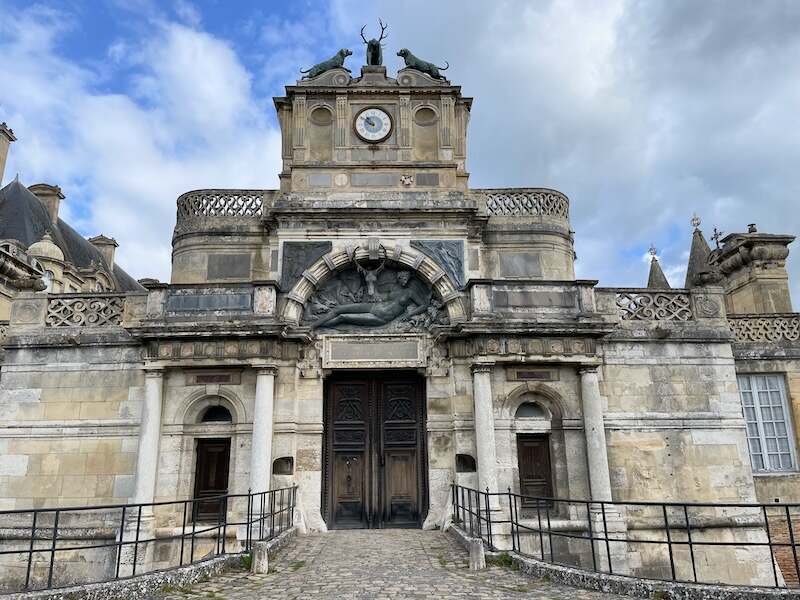 Diane de Poitiers was mistress of King Henry II of France - he built this palace for her ©Leyla Alyanak/OffbeatFrance
Diane de Poitiers was mistress of King Henry II of France - he built this palace for her ©Leyla Alyanak/OffbeatFranceDiane first set foot in Anet in 1515 when she married Louis de Brézé, but in those days the property consisted of a brick-faced 15th-century manor house, parts of which are still standing. When her husband died, it passed on to Diane.
Henri II would commission his favorite architect, Philibert de l'Orme (sometimes spelled Delorme), to build a handsome castle on the grounds for Diane, confirming her importance at court. It would also be a place for them to meet away from court.
Diane’s exquisite taste combined with Delorme’s talent delivered a true jewel of the French Renaissance, from its sculpted reliefs by Jean Goujon to the elaborate façade to those many design elements − nature, mythology, pilasters, pediments, and niches – that reminded everyone of classical Antiquity, so popular at the time.
Her exquisite taste called for exceptional art, and she commissioned works from prominent artists like Benvenuto Cellini to decorate the palace. You can still see the replica of Cellini’s famous nymph of Anet, or “Nymph with a Stag” over the entrance, a bronze relief whose original now sits in the Denon wing of the Louvre museum in Paris.
Diane’s legacy
Arriving at the Chateau d’Anet isn’t very chateau-like: there’s a moat and there are walls, but the chateau is basically on the street, not hidden behind miles of grounds.
Over the entrance I’m greeted by the classic view of Cellini’s nymph, and it’s clear I’m entering a special place: it is, after all, the home of one of the French Renaissance’s most influential women.
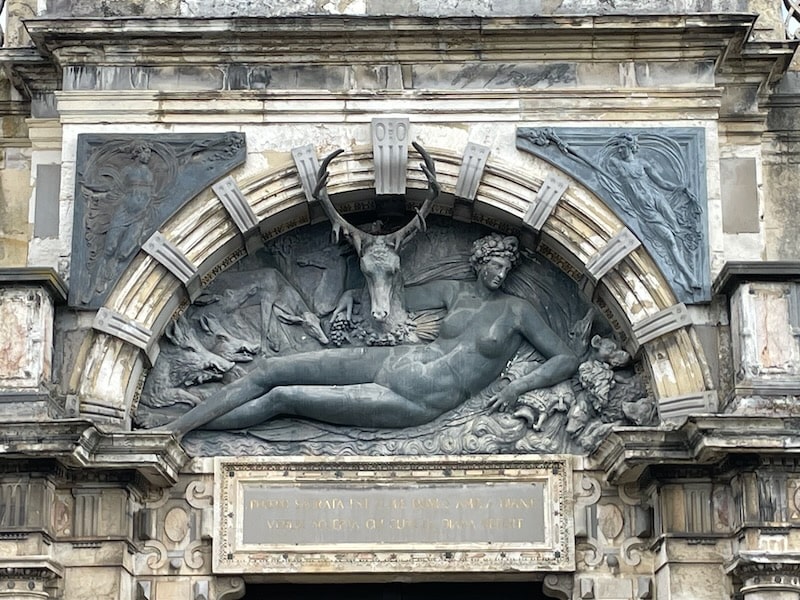 The replica of Cellini's Nymph of Anet over the chateau's entrance portico ©Leyla Alyanak/Offbeat France
The replica of Cellini's Nymph of Anet over the chateau's entrance portico ©Leyla Alyanak/Offbeat FranceThe entire façade is magnificent – a triumphal arch as entrance, a sculpture of deer and dogs which was once automated – its grandeur gives us a strong indication of just how magnificent it must have been.
Throughout my visit, I’ll try to catch a glimpse of Diane, whose souvenirs I’ll find here and there, peeking out of glass cases or hung on the walls.
Inside Diane's castle
While most of her furniture has gone, enough remains to give us a sense of her taste and personality.
Her bed, for example, is classified as a national historical monument. A lock of her hair was found and tested, and confirmed she ingested gold to stay young.
Plenty of her other possessions are displayed, like her hunting gloves, her cross-shaped timepiece, and a letter she wrote to Henri, along with a variety of other objects.
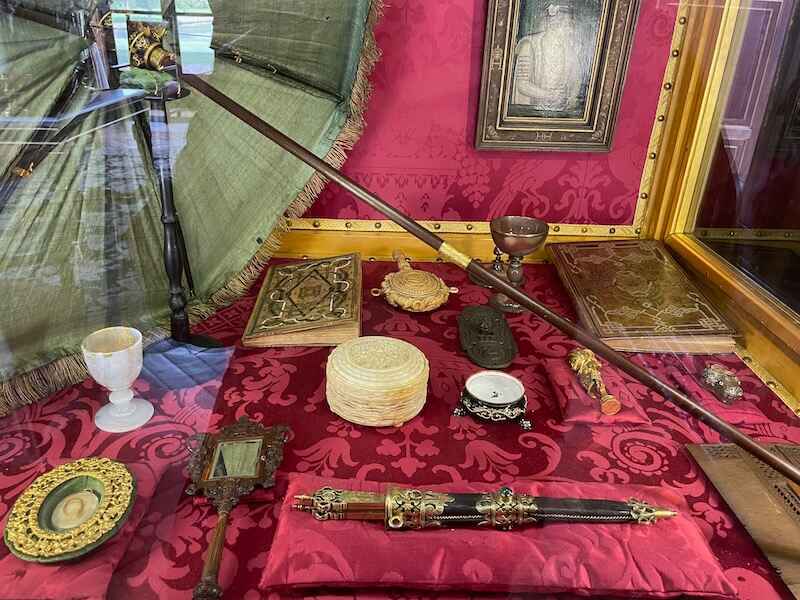 Remaining objects which once belonged to Diane on display in the chateau ©Leyla Alyanak/OffbeatFrance
Remaining objects which once belonged to Diane on display in the chateau ©Leyla Alyanak/OffbeatFranceWhile much of what Diane owned may be gone, her belongings were replaced with 16th-century tapestries and furniture, giving us a sense of her era.
Sadly, her fabulous library, one of France’s largest, was dispersed in 1724 to pay for the château's upkeep.
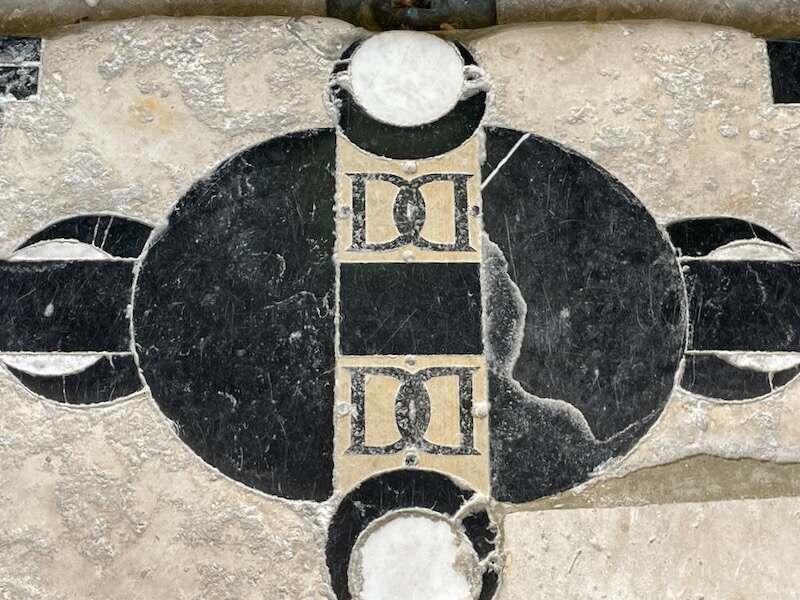 Diane's sign, two interlaced letter Ds, can be seen throughout the chateau ©Leyla Alyanak/OffbeatFrance
Diane's sign, two interlaced letter Ds, can be seen throughout the chateau ©Leyla Alyanak/OffbeatFranceThe chapel and the tomb
The château has not one, but two chapels.
The original chapel, displaced years ago from its original location across the courtyard, is an architectural gem designed by Delorme. Its dome-shaped ceiling is a maze of interlaced pieces providing an optical illusion of great height. But even better is the floor, designed to replicate the ceiling.
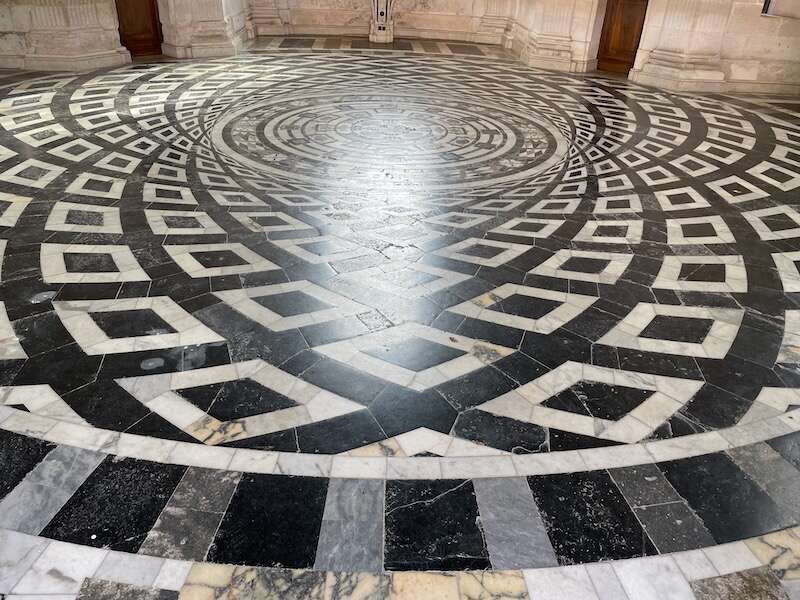 The chapel's floor, designed by Philibert de l'Orme to be a mirror image of the ceiling ©Leyla Alyanak/OffbeatFrance
The chapel's floor, designed by Philibert de l'Orme to be a mirror image of the ceiling ©Leyla Alyanak/OffbeatFrance The chapel's ceiling. Photo Binche, CC BY-SA 3.0, via Wikimedia Commons
The chapel's ceiling. Photo Binche, CC BY-SA 3.0, via Wikimedia CommonsThe other structure is Diane’s funeral chapel.
Diane had drawn up plans for her own funeral and included these in her will: she asked that her body be buried at Anet but her heart should join her husband at Rouen. Burying different parts of the body here and there was a custom at the time.
But when the French Revolution broke out, her body was exhumed and thrown into a common grave nearby. Eventually it would be unearthed, DNA-tested, and reburied in the funeral chapel in 2010.
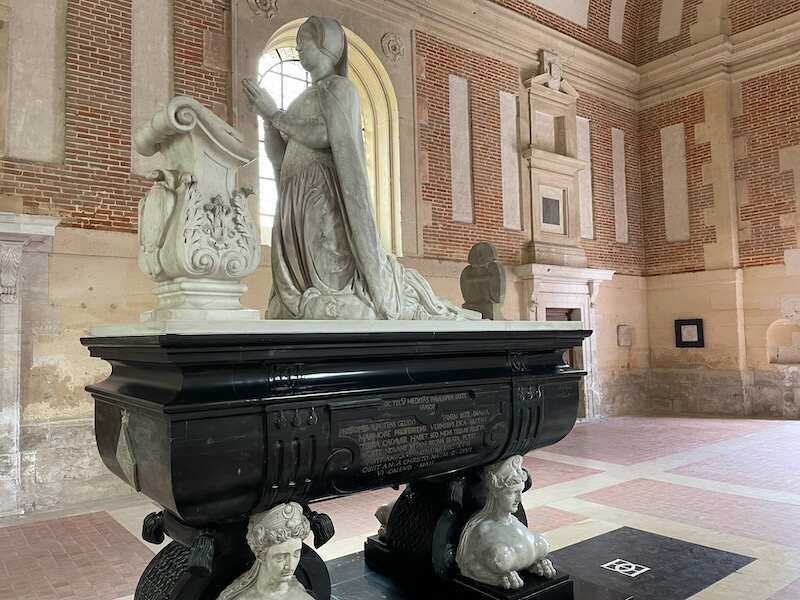 The sarcophagus which now holds Diane's remains ©Leyla Alyanak/OffbeatFrance
The sarcophagus which now holds Diane's remains ©Leyla Alyanak/OffbeatFranceAND FOR HISTORY OF A DIFFERENT KIND...
If you're a fan of James Bond movies, you may remember Sean Connery's jetpack escape scene in Thunderball, which takes place... right here at the funeral chapel. The château's courtyard also features in the Return of the Pink Panther.
The many restorations of Anet
When Diane died at the age of 66, Anet would be handed down through relatives and some restoration efforts would be made – not always with the happiest results. Her fountain would be moved, her beautiful garden redone, stained glass windows removed and space rearranged.
That's understandable, given that she died more than 450 years ago and the château has had 27 different owners since, many of whom added things – and removed things.
In the 17th century, the castle was significantly “modernized” by the Duke of Vendôme. Versailles was all the rage in those days, and he felt Anet was too, how shall we say, “Diane-ish”.
He modified her original plans and layout, adding rooms and bathrooms, with some renovations better than others.
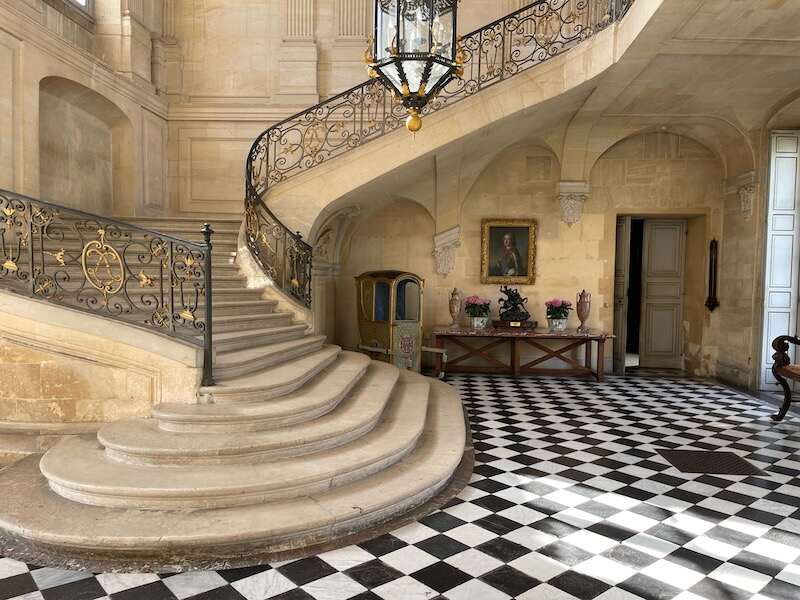 This stairway isn't the original - it was built during one of the many renovations ©Leyla Alyanak/OffbeatFrance
This stairway isn't the original - it was built during one of the many renovations ©Leyla Alyanak/OffbeatFranceThe worst damage would be caused by the destructiveness of the French Revolution.
As happened then, the Revolution nationalized the château and revolutionaries pillaged it, carting away anything that wasn't nailed down. Local villagers salvaged what they could, protecting pieces in their own homes until the Revolution had passed and these could be returned.
Parts of the original U-shaped building were dismantled and sold for stone, which explains why two-thirds of it are gone (only one of Diane’s three original wings remains – the central body and the most of the right wing were destroyed). A crescent-shaped stairway led to the gardens. We know all this because one thing that did survive the Revolution were Delorme’s architectural plans.
Degradation continued after the Revolution but at one point in the early 19th century, it all came to a halt when a local roofer fell to his death, which whipped villagers into a riotous frenzy. They saw the demolition as a sign of bad luck stopped work, leaving the one wing we have today.
Renovations finally began in earnest in 1840 and five generations of a single family would revive the chateau to some of its former glory.
During World War I it served as a Red Cross hospital and during World War II, it was used by German forces.
Today, it is owned privately and inhabited by the Yturbe family, who live in another, private part of the castle.
How to visit Anet
Throughout the chateau, you’ll find signs of Diane, and since you can only visit on a guided tour (here are the schedules and rates, in French) these will all be pointed out. Make sure you ask about English language visits. When I was there, my guide said she was sprucing up her English and that tours in English would soon be in the offing.
Across the street from the chateau is the excellent Center for the Interpretation of the Renaissance, or CIR. Most of it is in French, however, but it is ideal for history enthusiasts and visitors looking to immerse themselves in the splendor of the French Renaissance. Plus, you get a great view of Anet from its rooftop…
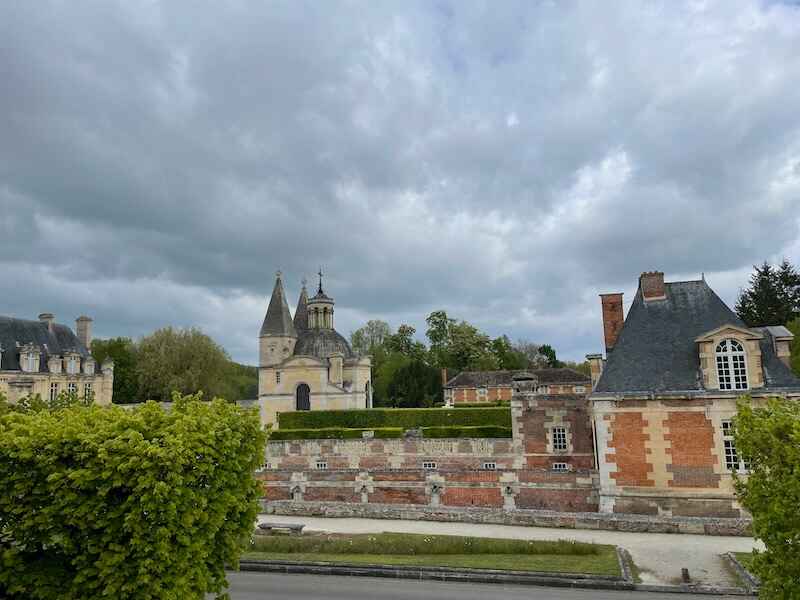 The Chateau d'Anet seen from across the street ©Leyla Alyanak/OffbeatFrance
The Chateau d'Anet seen from across the street ©Leyla Alyanak/OffbeatFranceBefore you go
Anet is located in a highly historical triangle and if you have a car and can get around, this is your chance to experience several slices of French history.
Locally, within the Eure-et-Loir department, you can visit three unusual castles, of which Anet is one. You can also head to the Royal Domain of Dreux, where the last king of France, Louis-Philippe, is buried, as members of the Orleans family continue to be upon their death.
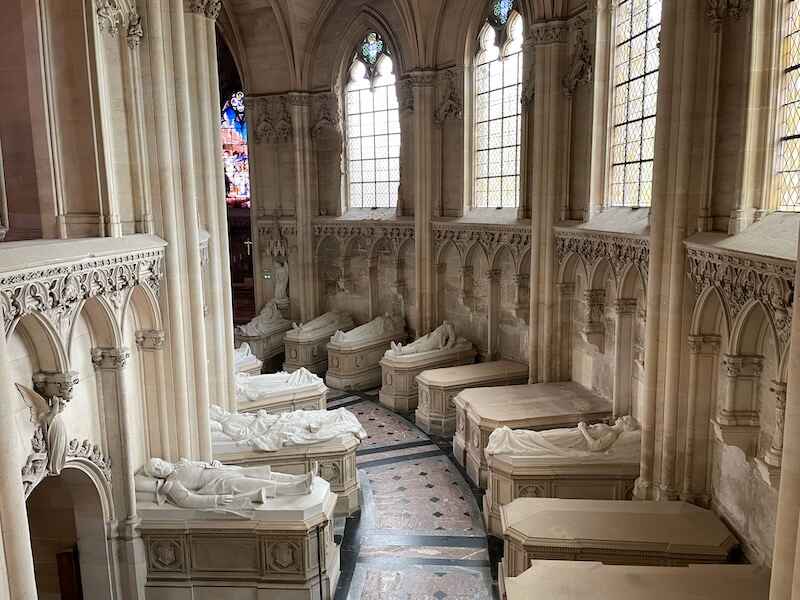 The Royal Necropolis of Dreux, final resting place of the Orleans branch of the French royal family ©Leyla Alyanak/OffbeatFrance
The Royal Necropolis of Dreux, final resting place of the Orleans branch of the French royal family ©Leyla Alyanak/OffbeatFranceThe Orleans, by the way, are one of two families (the other is the Bourbon family) who claim the rights to the French throne, should such a thing ever reappear.
And if you need a place to stay in Anet, I would love to recommend the delightful L'Atelier et Après, a stone's throw from the chateau. The hostess, Catherine, is a retired interior designer and her three guest rooms were a delight, as was her cooking!

